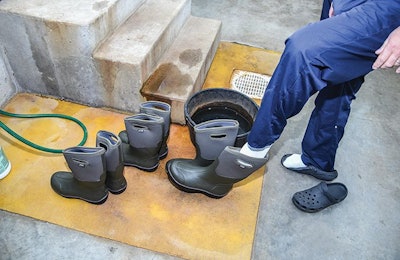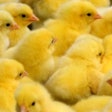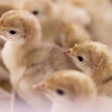
Biosecurity is a required investment for poultry producers and maybe the only method of controlling diseases when treatment and/or vaccination are not options. A robust biosecurity program is essential to keep flocks safe.
By practicing biosecurity procedures every day the risk of introducing diseases is reduced, helping to keep birds safe and healthy.
People are considered to be the single most important source of diseases on a farm as a disease may be transported on to the farm through contaminated clothing, footwear and equipment. Each employee must understand the importance of effective biosecurity and their role in carrying out a successful biosecurity program.
Implementing the following 14 biosecurity basics can help to keep disease out, flocks healthy and production interrupted.
- Always follow the age rule: Visit the youngest birds before the older birds and never go the other way.
- Always keep a logbook of who is entering the farm with:
- Full name.
- Last time they had contact with poultry and where.
- Date and reason for the visit.
- If the flock last visited was diseased.
- Limit all vehicular traffic onto a farm. Have a vehicle dedicated to the farm if needed. If a vehicle must enter the farm, it should be washed and disinfected before entering. Always wash and disinfect tires, foot pedals, the steering wheel, seats and floors of vehicles entering the farm using a combination of wet disinfection by sprayer, aerosol sprays, and disinfectant wipes.
- Always wear shoe covers, coveralls, hairnets and gloves, and remove all personal items, such as phones, wallet or keys, to minimize the introduction of disease agents into the flock being visited.
- Having dedicated farm footwear — and even footwear dedicated to a specific house — is a simple step to keep disease agents out.
- Always use foot baths and hand sanitizer at specific points of entry before having bird contact. For example, at the first entry point into the house and again at the entry into the flock.
- Always have biosecurity procedures posted, but more importantly, be sure all personnel and growers have been trained and understand the procedures and policies.
- Always keep biosecurity signs posted to restrict visitors to the farm.
- Be cautious of local gathering places for growers, such as restaurants and coffee and hairdressing shops. These can be sources of cross-contamination.
- Growers and farm caretakers must avoid contact with other avian species, for example at pet/farm stores selling chicks, at county fairs, or bird hunts.
- It is not recommended to share equipment between farms, especially when birds are present.
- Always maintain effective pest control measures, particularly for rodents, flies, and litter beetles.
- Do not allow pets, livestock, wild animals or wild birds to enter houses.
- Always keep doors to houses securely locked.
Biosecurity needs to be at the heart of farm culture and regularly reviewed to ensure that procedures are being followed correctly and giving the intended results. A lapse in biosecurity, even when small, can result in significant losses that far outweigh the costs of ensuring that a biosecurity program is strictly adhered to.

If a vehicle must enter the farm, wash and disinfect it prior to entering including foot pedals, the steering wheel, seats, and floors of the vehicle. | Winfridus Bakker, Tech Services, Cobb-Vantress, Inc.
4 tips for poultry farm biosecurity

















